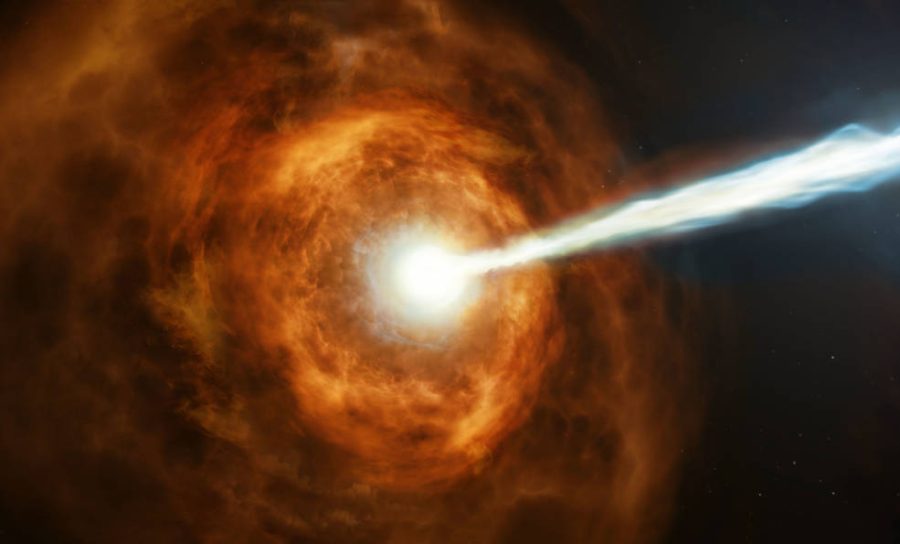NU astrophysicists observe brightest gamma-ray burst ever detected
An artists’ rendition of a gamma-ray burst observed by NASA in 2019. In October 2022, the brightest ever gamma-ray burst was recorded near the constellation Sagitta.
January 19, 2023
Last October, Northwestern fourth-year Ph.D. student Jillian Rastinejad woke up in the early morning while visiting colleagues at the University of California, Santa Barbara to apply for use of the Gemini-South telescope in Chile.
Her focus was pinpointed: to observe the brightest gamma-ray burst ever recorded.
NASA’s Fermi Gamma-ray Space Telescope, Wind Spacecraft and Neil Gehrels Swift Observatory first detected the explosion just days before near the constellation Sagitta, about 2.4 billion light-years from Earth.
While the astronomy community is alerted weekly about gamma-ray bursts — the brightest known explosions in the universe — this one was different.
“If past gamma-ray bursts are like turning on a light bulb, this gamma-ray burst is like turning on all of the floodlights in a football stadium,” Rastinejad said.
These past few months, astrophysicists in Rastinejad’s cohort at NU and around the world have been eager to observe the explosion — called B.O.A.T., or “brightest of all time” — and see if the burst could help answer foundational universal questions.
Rastinejad and graduate students at the University of Maryland and The George Washington University were the first to make observations about the burst.
Long-duration gamma-ray bursts like B.O.A.T. emerge when a core of a massive star has collapsed into a black hole, which is a region of spacetime where gravity is so strong that even light cannot escape.
In radio and X-ray wavelengths — as well as in optical light — astronomers can observe an afterglow effect caused by outward jets of material from a black hole’s accretion disk. These wavelengths become the basis of observations of the burst.
After B.O.A.T. was first detected in October, astronomers only had about a month to observe the event. Astrophysics Prof. Wen-fai Fong, who advises Rastinejad at the Center for Interdisciplinary Exploration and Research in Astrophysics, said the initial observation window was slim because the burst occurred close to the sun.
“You can imagine, a star that’s kind of close to the sun sets shortly after the sun,” Fong said. “With each passing day, we get less and less time with it until it will eventually go behind.”
Astronomers weren’t able to find definitive evidence for the presence of a supernova, a super-powerful explosion of a star, during the initial observation window.
There’s an established link between long-duration bursts and supernovae, according to CIERA postdoctoral fellow Peter Blanchard, but the explosions usually happen so far away from Earth that astronomers can’t be sure.
The B.O.A.T. occurred 2.4 billion light-years away, meaning it has taken more than two billion years for light, which has the fastest speed in the universe, to reach Earth. According to Rastinejad, the vast majority of bursts happen farther away in the universe, which is around 13.8 billion years old.
“The ones that are close enough — we see a supernova,” Blanchard said. “That’s the strongest piece of evidence that’s telling us these gamma-ray bursts come from massive stars because massive stars explode as supernovae.”
Blanchard recently got a program approved to use NASA’s James Webb Space Telescope, launched in December 2021, to further study the burst.
According to Fong, while astronomers detect multiple gamma-ray bursts a week, only about 1% of stars that undergo a supernova end up also producing a burst. Scientists don’t know what makes these stars special, she said.
“It just really emphasizes to me how big the universe is, how rare these explosions are and how we’re really just observing the extremes of the universe,” she said.
The gamma-ray burst should come back into telescopic view in early February, meaning astrophysicists will have more time to conduct observations.
Fong said B.O.A.T. could provide direct evidence on the origin of elements heavier than iron, which astronomers have yet to determine.
“I think that’s one thing that’s really amazing about our universe is that we never know unless we look,” Fong said. “That’s kind of a serendipity of gamma-ray bursts in this field that I really love.”
Rastinejad said observing the explosion as a young person in astrophysics was exciting because it’s a reminder that the field still surprises her.
On a personal note, she added that her ability to observe the burst shows that dedication pays off.
“If you work really hard and you’re really, really excited, then sometimes the universe works out for you,” she said.
Email: [email protected]
Twitter: @JorjaSiemons
Related Stories:
— Dearborn Observatory and CIERA host public viewing of total lunar eclipse
— Jason Wang brings years of experience in exoplanet imaging to Northwestern












